Of all the short hikes in Pacific Rim National Park Reserve, the Shorepine Bog boardwalk loop is the one that I keep coming back to again and again, and if I was going to suggest just one walk in the region it’d likely be this one. The Shorepine Bog loop leads through a stunning and ecosystem consisting of gnarled and stunted trees specially suited to their harsh environment. Unlike other old-growth forests on Vancouver Island which are home to giant trees the size of buildings, the shorepines can be just centimeters thick despite being hundreds of years old! This a result of the acidic soil and lack of nutrients available in this region. Because of the very high water table, bog trees develop very short roots – up to roughly 10 centimeters. I have heard more than one person compare the unusual-looking trees to something out of a Dr. Suess book and I can’t say I disagree.
The boardwalk through this unique environment is only about 800 meters long, and sees fewer visitors than other more dramatic trails near Tofino, making it easy to have it all to yourself.
Continue reading this blog post for everything you need to know to experience the Shorepine Bog Trail near Tofino on Vancouver Island for yourself, including distance, elevation gain, how to get there, the best time to visit, and lots of photos of my experience.
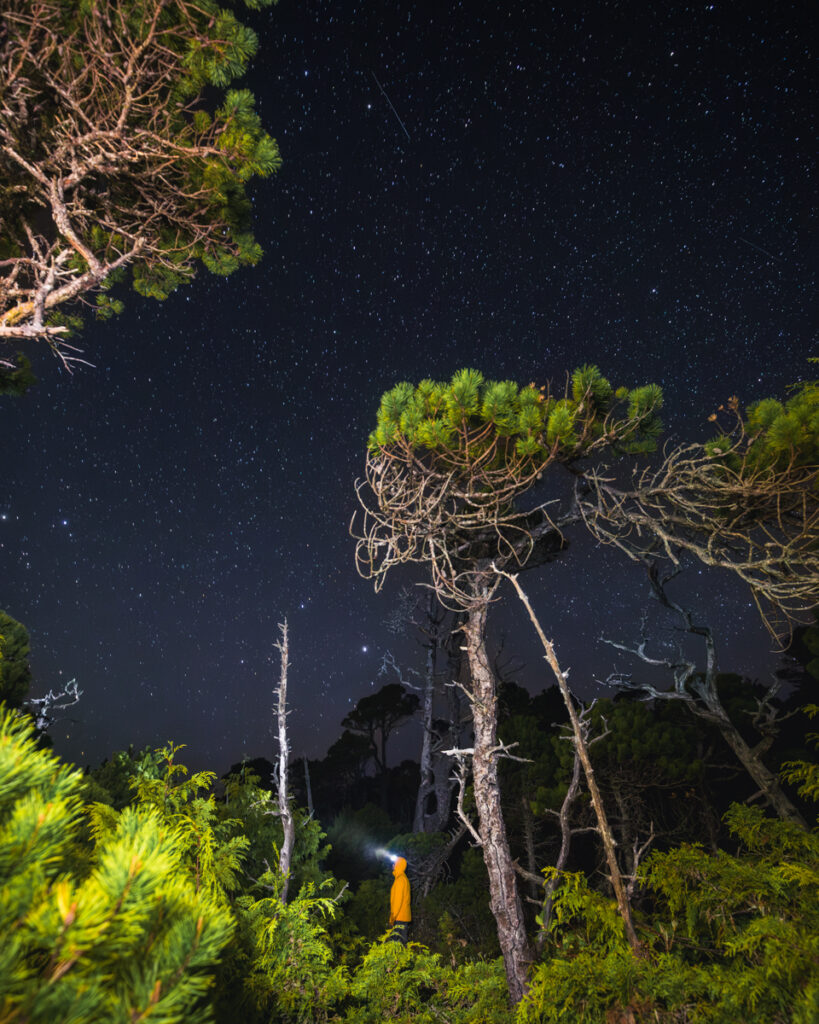
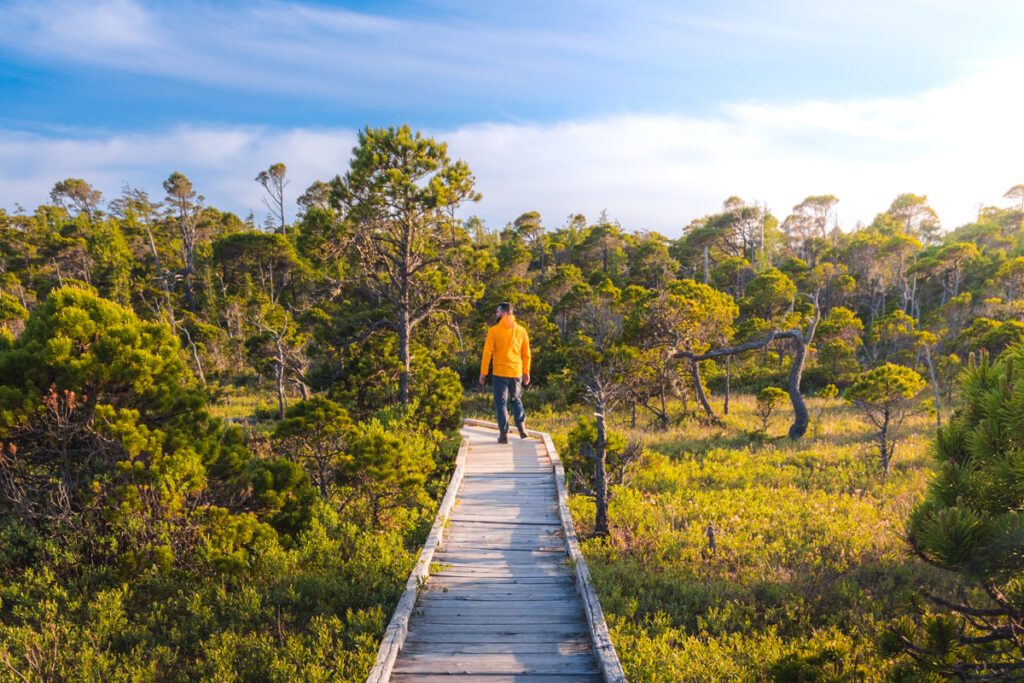
Note: The Shorepine Bog Trail is located in Pacific Rim National Park Reserve, meaning that a valid park pass is required. Day passes can be purchased at the park gates and are per day per person, but if you’re staying a week or longer, it’s more cost-effective to just buy an annual pass instead.
Before visiting Pacific Rim National Park Reserve it’s essential to read up on the Parks Canada rules that must be followed to avoid tickets and/or fines. When hiking it’s important to avoid harmful practices such as disturbing plants or rock-stacking, or removing any natural object from flowers to rocks, as it’s important to leave the environment as natural as possible for the animals and for fellow hikers to enjoy in perpetuity. As many flowers as there are, there are few enough that if we all took one, then there wouldn’t be any left. If you’re after a souvenir to take home with you, there are tons of gift shops in the Banff townsite to check out. Otherwise take only photos, leave only footprints.
If you haven’t heard of Leave No Trace principles, they’re also really essential to read up on before heading anywhere into the outdoors in general. Following these important principles basically means doing your best to leave beautiful places like the Shorepine Bog Trail as good (if not better) than you found them, both for their preservation and for the enjoyment of other visitors.

Shorepine Bog Trail Round Trip Details
Distance: 0.8 KM / 0.5 MI
Elevation Gain: None
Hiking Time: 15 mins
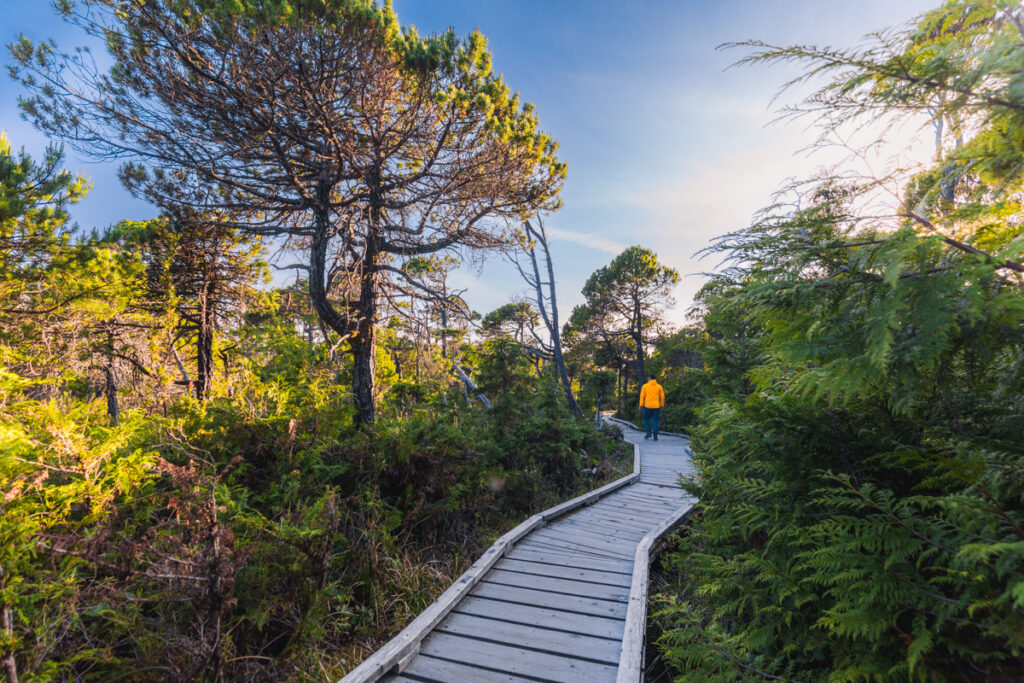
Hiking & Safety Tips
- Prepare for the possibility of wildlife encounters. There are almost no grizzly bears on Vancouver Island, but black bears and cougars are still common. Bear bells are proven to be an ineffective bear deterrent, and are even actively discouraged by Parks Canada. The best way to let wildlife know you’re around is simply to use your voice. Make sure to keep a respectful distance from wildlife and never feed the animals. It may seem kind but it doesn’t just kill wildlife and put people in danger, it’s also in many cases illegal.
- Research current trail conditions and make sure you are well-informed about the route before you leave, and assess if it is within your capability. Be aware of what time it gets dark and check the weather forecast. Make sure to tell someone where you’re going and when you expect to return. Every year as more and more people try hiking for the first time, the number of rescues goes up. Being prepared is the best defense.
- Pack everything you need for a successful hike, including enough water and energy-rich snacks. Remember to pack out everything you pack in though – don’t expect to find a convenient garbage can halfway up the trail. Bring appropriate layers (remember you’ll warm up once you start hiking) and sun protection. Hiking poles may be helpful but are not required. In addition to not leaving any garbage on the trail yourself, I highly recommend bringing a garbage bag and collecting any trash that you do see on the trail. You’re guaranteed to make the hike along the Shorepine Bog Trail a more enjoyable experience for the next person.

How to Get to the Shorepine Bog Trailhead
The Shorepine Bog Trail is located in Pacific Rim National Park Reserve, about half an hour from Tofino or 15 minutes from Ucluelet. To get to the Shorepine Bog trailhead drive along the Pacific Rim Highway – about 6km north of the junction between highways leading to Tofino, Ucluelet, and Port Alberni. Turn south onto Wick Road. There are few other roads turning off this section of the highway so it should be hard to miss. Keep straight on Wick Road, ignoring a turnoff on the left for Florencia Bay beach access. No more than a minute past that turnoff a small parking area will be visible on the left for the Shorepine Bog Trail. There’s a machine at the parking lot to buy your park pass, but it isn’t always working.
Click here to open the exact trailhead location in Google Maps.
Hiking the Shorepine Bog Trail

The beginning of the Shorepine Bog Trail from the small parking lot.
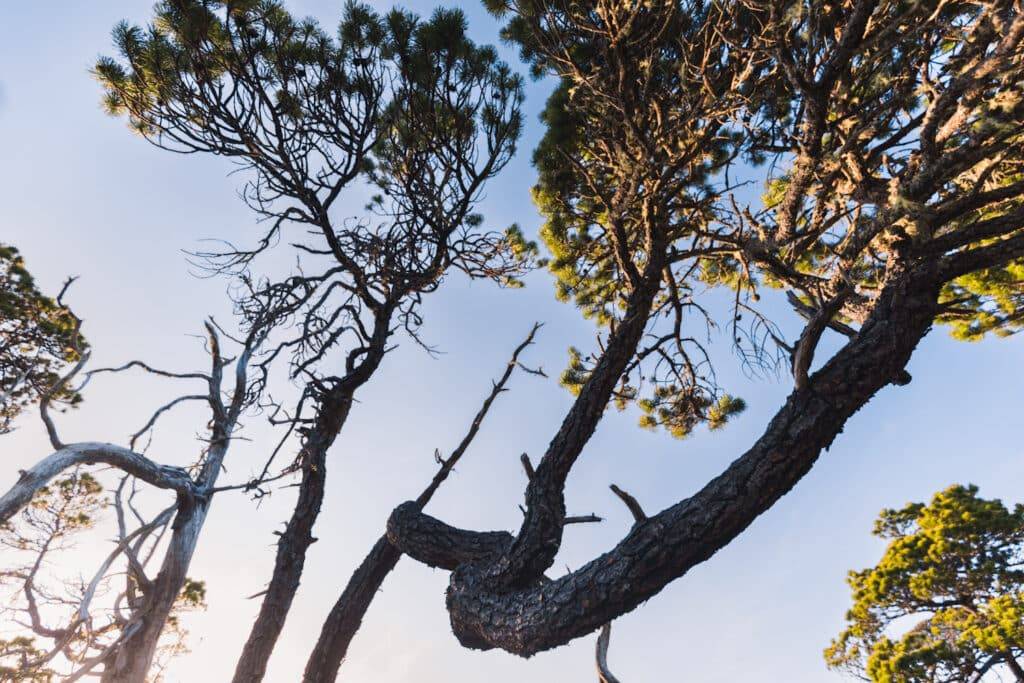
Twisted and gnarled shorepine limbs hang over the trail.
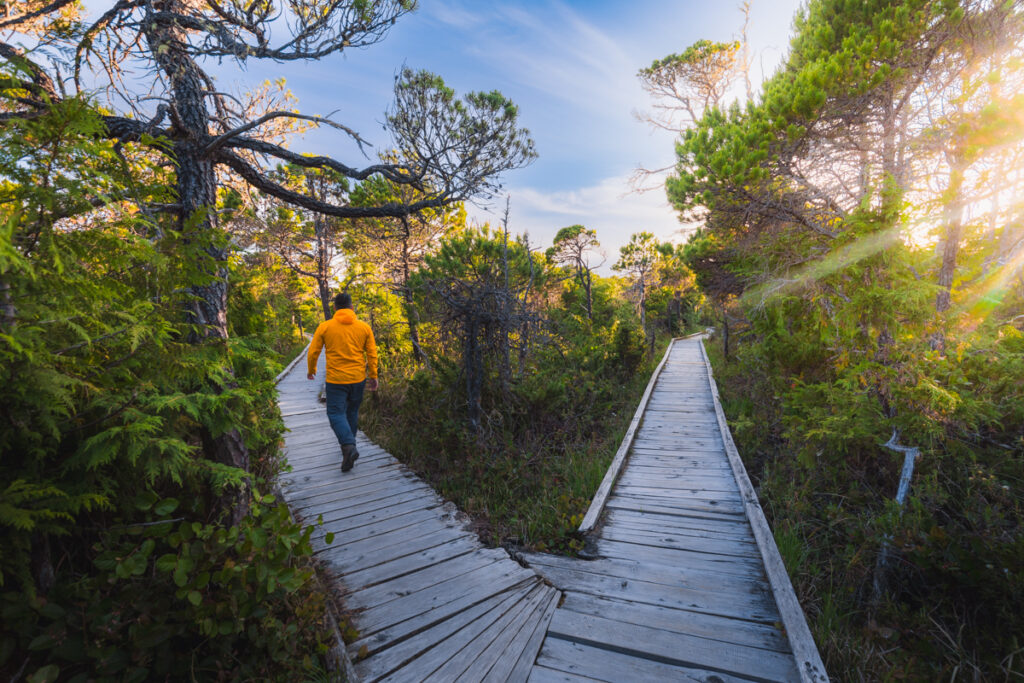
Pretty quickly the creaky wooden boardwalk splits in two to become a lolipop loop. I’ve done it in both directions and can’t say it really matters which way you go.
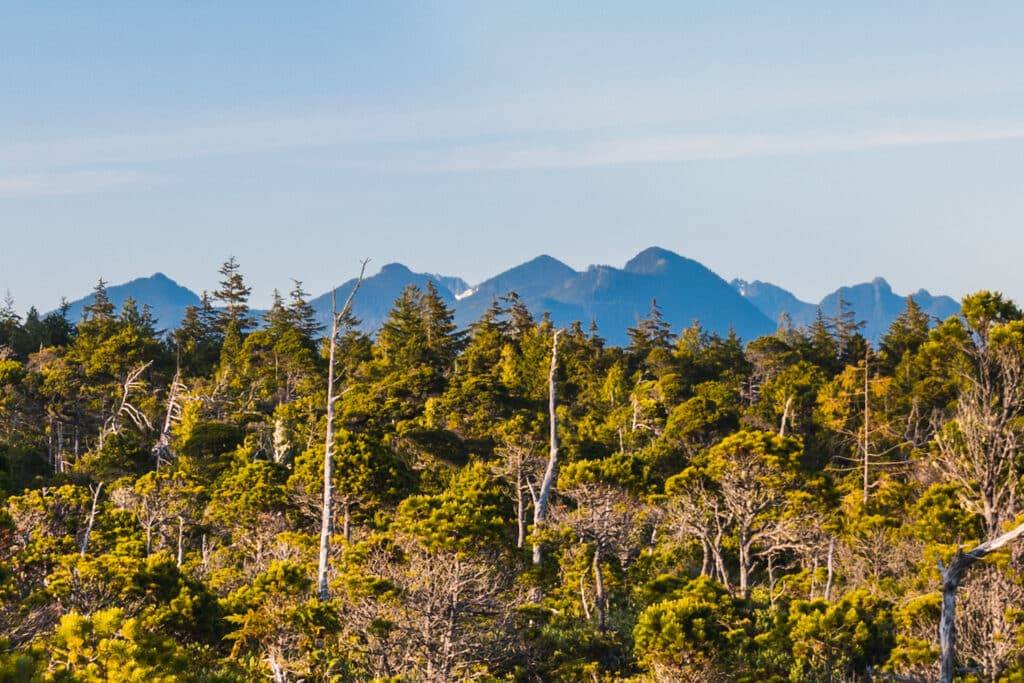
From the trail a distant mountain range can be seen. These peaks are on the other side of Kennedy Lake, not far from the highway connecting Pacific Rim National Park Reserve with the rest of Vancouver Island.
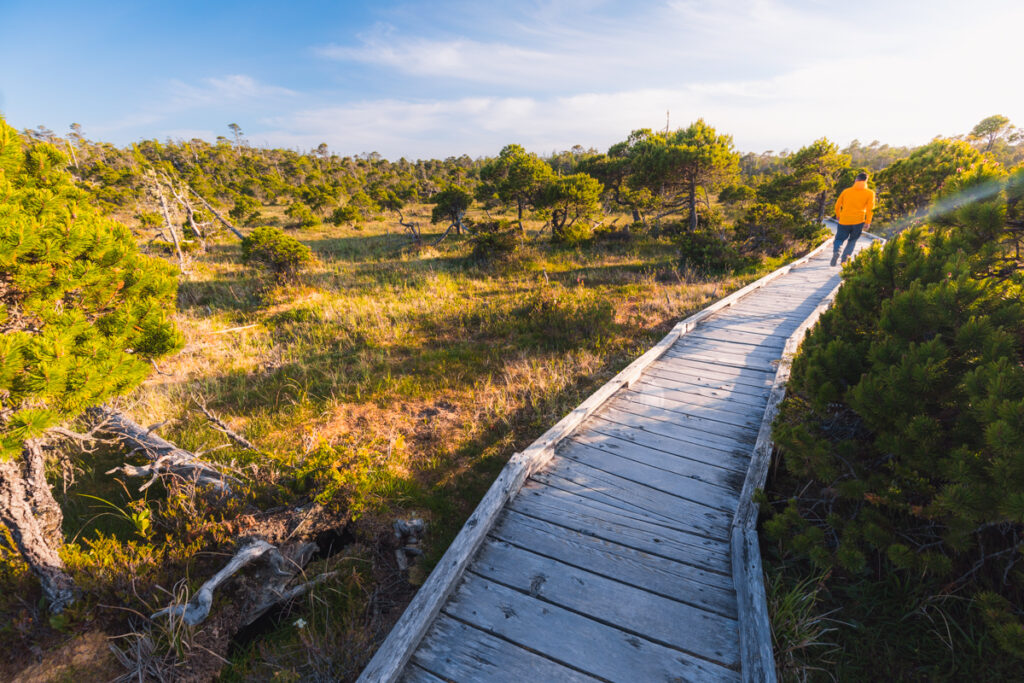
Some areas are more open with grasses and mosses. The delicate, slow-growing bog species are easily crushed and can take a very long time to recover, so don’t be a jerk and stay on the trail.
Recommended Hiking Gear



Water is a must whenever I’m hiking, especially if the sun is going to be out. My favourite water filter I’ve used is the Katadyn BeFree 0.6L, which unlike other water filters I’ve used packs up really small and lightweight. For hikes where I know there won’t be any readily available water sources along the way, I make sure to bring my own. The Hydrapak Stow 1L bottle is my go-to, for the same reason that it’s made of a soft plastic that folds up and doesn’t take up any more extra space than necessary in my pack. Finally, Aquatabs are another great option for purifying water, with one tablet being suitable for one litre of water. I previously used the Grayl water filter while travelling internationally, and though I found its hard body more convenient for day to day use and easier to drink from, it has a little too much bulk for my fast-and-light style of hiking.



The secret to all my photos of gorgeous sunset and sunrise mountaintop views? A lot of hiking in the dark. And let me speak from personal experience when I say that the last thing that you want to happen when hiking is to be caught in the dark without a headlamp. I used the Black Diamond Spot 400 for years and it worked great – until I lost it on top of a mountain somewhere. The only downside to it was having to worry about the batteries dying, though there’s also a slightly more expensive version that has a rechargeable battery. Nowadays I’m using the Petzl Actik Core, which is a bit pricier than the more budget-friendly Black Diamond, but is also brighter, more comfortable (in my opinion), and has a hybrid power system that is rechargeable but can also take AAA batteries if needed.
You won’t see me using trekking poles on shorter hikes often – but on long hikes and backpacking trips, as well as certain scrambles, they are an absolute lifesaver. I’ve invested in a high quality ultra-lightweight pair of MSR DynaLock Ascent carbon poles which, while pricey, I don’t regret one bit. If you’re not entirely sure how much use you’re going to get out of a pair of trekking poles, the best budget-friendly option would be the Trekology Trek Z 2.0. Amazon does sell a lot of cheaper Made in China-style trekking poles for cheaper, but these usually are much much heavier and not worth buying.
All the best and most long-lasting cables and power banks I’ve ever owned have been Anker. I once had a phone cable from them that lasted me over three years of daily use! That’s why I keep an Anker PowerCore Essential 20K power bank on me. Like many people I use my phone for a lot of stuff when hiking (checking in with family, using online maps, taking photos, flying my drone) so I like to be prepared for that low battery warning by having a backup power source on me just in case.



The only socks I ever buy for myself are from Darn Tough, and I almost always make sure to wear them when hiking. After years of having no problems only wearing these comfortable and rugged socks for hikes, I accidentally wore a pair of no-name socks on a hike last year and ended up with blisters on both feet. Safe to say I’m back to sticking with the Darn Tough. And the best part? They have a lifetime guarantee, meaning that if they ever wear out you can send them back for a brand new pair. For hiking footwear I go between a pair of lightweight approach shoes for quick and dirty mountain ascents or anything involving scrambling and more heavy-duty boots for longer treks. I’ve worn a couple different versions of the lightweight but super durable Arc’teryx Konseal FL 2 approach shoes for a few years now and am very impressed with the durability. I also really like the thick toecap that keeps me protected every time I stumble into a root or large rock. For longer, tougher, or muddier treks I rely on my LOWA Camino EVO GTX, which I find insanely comfortable and made of very high quality.



I wear my Ar’teryx Gamma Lightweight Pants on every single hike I go on, and on many days when I’m not hiking. After several years of abuse they are still holding together extraordinarily well, with only a few small holes from where I’ve fallen down and some slight stains from being repeatedly coated with mud. They’re lightweight, breathable, and super comfortable. For lightweight and breathable hiking tops I’m a big fan of both the Patagonia Capilene Shirt and the MEC Core Shirt. My Arc’teryx Squamish Hoody shows up in a lot of my photos. It’s super lightweight and packable, and does a great job of cutting the wind while also being pretty breathable. I also have an Arc’teryx Atom Hoody and Arc’teryx Beta LT that I pull out for cooler or wetter conditions.
I hope you enjoyed this guide to hiking the Shorepine Bog Trail near Tofino on Vancouver Island! Feel free to leave any questions in the comment section below or to contact me directly via social media.
